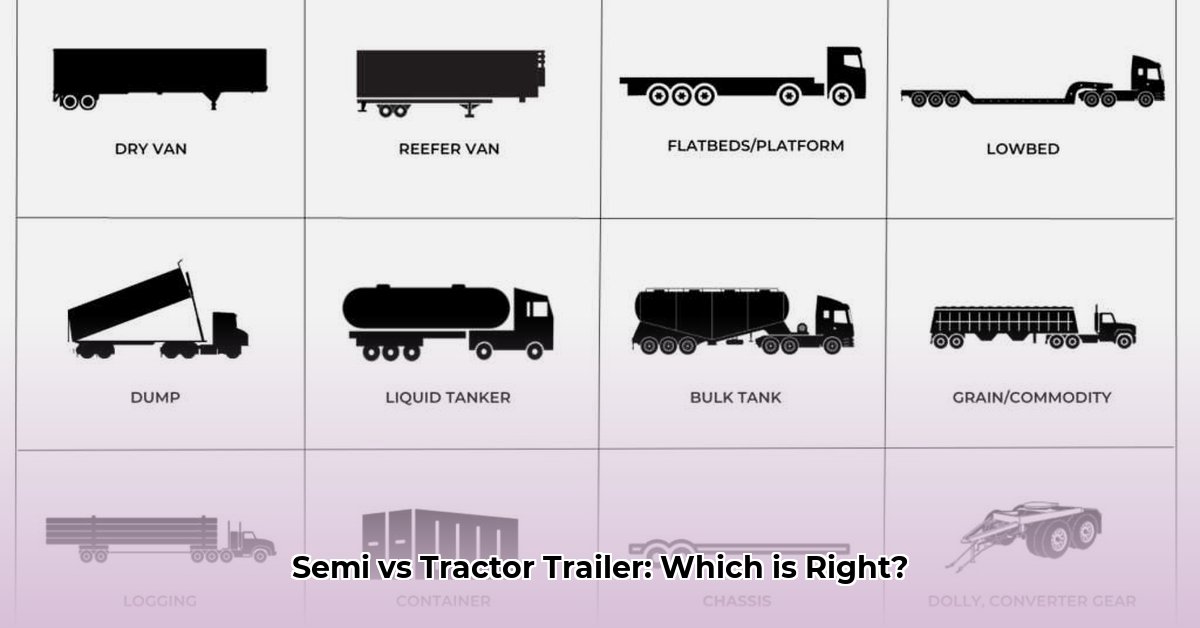
Understanding the Core Differences: Semi-Truck vs. Tractor-Trailer
Let's clarify the often-confused terms "semi-truck" and "tractor-trailer." A semi-truck, also known as a tractor unit, is the power unit—the engine, cab, and chassis. It's the vehicle that does the pulling. A tractor-trailer, on the other hand, is the complete combination: the semi-truck plus one or more trailers carrying the cargo. It's the entire transportation unit ready to hit the road. Think of it as the difference between an engine and a complete car. For more on trailer dimensions, see tractor trailer size.
Dissecting the Components: A Detailed Breakdown
To fully grasp the distinction, let's examine each component:
The Semi-Truck (Tractor Unit)
This powerhouse consists of:
- Engine: Provides the power for hauling. Different engine types (e.g., diesel, natural gas) offer varying fuel efficiency and power outputs.
- Transmission: Transmits power from the engine to the wheels. Automatic and manual transmissions are common, each with its own advantages and disadvantages.
- Cab: The driver's compartment. Types include:
- Day Cab: Smaller, suitable for shorter trips.
- Sleeper Cab: Larger, providing sleeping space for longer hauls.
- Fifth Wheel: The crucial connection point between the semi-truck and the trailer.
The Trailer(s)
This is where the cargo resides. Numerous trailer types exist, each designed for specific goods:
- Dry Vans: Enclosed trailers for general cargo.
- Reefers (Refrigerated Trailers): Maintain specific temperatures for perishable goods.
- Flatbeds: Open trailers for oversized or oddly shaped cargo.
- Tankers: Transport liquids or gases.
- Specialized Trailers: Designed for livestock, hazardous materials, etc.
Choosing the right trailer is paramount for efficient and cost-effective operations.
Comparative Analysis: Key Feature Differences
Let's compare common setups:
| Feature | Day Cab + Dry Van | Sleeper Cab + Reefer | Heavy-Haul + Flatbed |
|---|---|---|---|
| Payload Capacity | Moderate | Moderate | High |
| Fuel Efficiency | Generally Higher | Lower (due to refrigeration) | Lower (due to weight/drag) |
| Operating Cost | Lower | Higher | Significantly Higher |
| Typical Use Case | Local/Regional Delivery | Long-haul, Temperature-Sensitive Goods | Specialized Heavy Cargo |
| Maneuverability | High | Moderate | Low |
Real-World Applications: Matching the Rig to the Job
The ideal semi-truck and trailer combination depends entirely on the task. Local delivery services may prefer smaller day cabs with dry vans for maneuverability and cost-effectiveness. In contrast, long-haul operations transporting temperature-sensitive goods require sleeper cabs and refrigerated trailers. Heavy-haulers need specialized setups for oversized loads, prioritizing robustness and stability.
Actionable Insights for Logistics Professionals
To optimize your logistics operations:
Strategic Trailer Selection: Choosing the correct trailer for each cargo type is crucial for efficiency and cost savings. Incorrect choices lead to delays and increased expenses.
Fuel Efficiency Optimization: Explore fuel-efficient engines, driving techniques, and aerodynamic trailer designs to reduce costs.
Invest in Driver Training: Comprehensive training enhances safety, reduces accidents, and improves route efficiency.
Embrace Technology: Utilize telematics and route optimization software for real-time fleet monitoring and improved planning.
Prioritize Maintenance: Regular maintenance prevents costly breakdowns and ensures operational continuity.
Isn't it fascinating how the right combination of semi-truck and trailer can dramatically impact your entire operation? By skillfully matching the right equipment to your specific needs, you can significantly improve efficiency and profitability in the dynamic world of logistics.